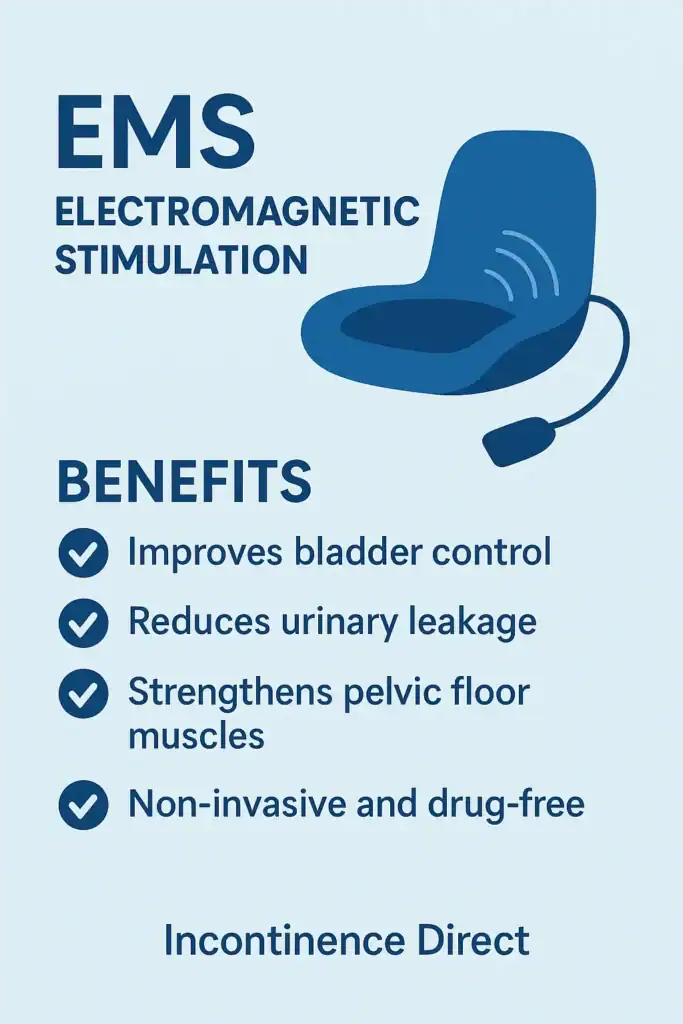Sit, Relax, Strengthen: How EMS Therapy Helps Stop Leaks Naturally

If you’re living with bladder leaks or urinary urgency, you’re not alone — and the solution might be more straightforward (and more comfortable) than you think. EMS therapy for incontinence, short for Electromagnetic Stimulation Therapy, is a non-surgical treatment that helps strengthen the pelvic floor and restore bladder control — all while you sit and relax.
At Incontinence Direct , we understand how important it is to find practical, comfortable, and non-invasive ways to manage incontinence. Let’s explore how EMS therapy works, why it’s such a breakthrough, and how it compares to surgical options.
Please speak to our team today!
What Is EMS Therapy for Incontinence?
EMS (Electromagnetic Muscle Stimulation) therapy uses gentle electromagnetic energy to activate and strengthen the pelvic floor muscles.
Here’s how it works:
- You sit fully clothed on a specially designed Electromagnetic Seat (EMS Chair).
- The seat delivers targeted pulses that contract and release your pelvic floor muscles — performing the equivalent of thousands of Kegel exercises in a single 30-minute session.
- Over a short series of sessions, the muscles become stronger and more responsive, leading to better bladder control and reduced leaks.
It’s a painless, non-invasive, and clinically proven method that helps both men and women manage incontinence without surgery or medication.
EMS (Electromagnetic Seat) can treat:
- Erectile Dysfunction
- Urinary Incontinence
- Stress Incontinence
- Mixed Incontinence
- Overactive Bladder
- Stool Incontinence
The Benefits of EMS Therapy for Incontinence

Benefit: What It Means for You
Improves Bladder Control Strengthens the pelvic floor, reducing leaks and urgency.
Non-Surgical & Drug-Free: No needles, anaesthetic, or recovery time needed.
Comfortable and Convenient Sessions last around 30 minutes — fully clothed and seated.
Rapid Results: Many people notice improvement in as little as 2–3 weeks.
Boosts Confidence and Quality of Life Restores normal bladder function, helping you sleep better, travel with confidence, and enjoy life without worry.
How Does EMS Therapy Compare to Surgical Treatment?
When comparing non-surgical EMS therapy to surgical procedures (like sling surgery or artificial sphincter implants), there are some clear distinctions:
Aspect EMS Therapy (Non-Surgical) Treatment
Invasiveness: Completely non-invasive — no needles or incisions. Involves surgery under anaesthesia
Recovery Time: No downtime — return to daily life immediately. Several weeks of recovery and restricted activity
Risk of Complications Minimal (mild muscle soreness at most). Possible complications such as infection or mesh-related issues
Comfort, Painless, and relaxing. Some discomfort during recovery
Cost: Affordable per-session approach, Higher one-time cost (and hospital fees)
Suitability: Ideal for mild to moderate incontinence or pelvic floor weakness. Non-surgical EMS therapy is a safe and highly effective first-line treatment, typically recommended for most individuals before exploring surgical options.
This therapy is particularly advantageous for post-childbirth recovery, addressing age-related muscle weakness, and providing essential support following prostate surgery.
See Our Current Prices And Promotions!
The Science Behind EMS Therapy

The EMS Chair uses high-intensity electromagnetic fields to engage the pelvic floor muscles thousands of times. During a single session, something impossible to achieve through voluntary Kegel exercises alone.
Each contraction enhances neuromuscular control, increasing the strength and endurance of the pelvic floor. Clinical studies show EMS therapy can:
- Reduce episodes of urinary leakage
- Increase pelvic floor muscle thickness and tone
- Improve bladder emptying and reduce urgency sensations
- Enhance sexual function in both men and women
Frequently Asked Questions (FAQ) About EMS Therapy
Q1: Is EMS therapy painful?
No. Most people describe it as a tingling or pulsing sensation. You sit back and relax while the machine does the work.
Q2: How soon will I see results?
You may notice improvement in bladder control after 2 to 3 weeks of regular sessions. Most people achieve optimal results after 6–8 treatments.
Q3: Is EMS therapy safe for everyone?
Yes, EMS therapy is safe for most individuals. However, it’s not recommended for those with pacemakers, metal implants in the pelvic area, or during pregnancy. Always consult your clinician before starting.
Q4: Do I need to undress for EMS treatment?
No, you remain fully clothed during your session. The electromagnetic waves penetrate clothing easily to reach the targeted muscles.
Q5: Can men use EMS therapy for incontinence?
Absolutely. EMS therapy benefits both men and women — including men recovering from prostate surgery or age-related incontinence.
Q6: How long do the results last?
Results can last several months. Regular pelvic floor exercises or occasional maintenance sessions help prolong the benefits.
Q7: Can EMS therapy help with other issues?
Yes — aside from bladder control, EMS can improve core stability, posture, and even enhance sexual wellness by strengthening pelvic muscles.
Why Choose Incontinence Direct ?
At Incontinence Direct, we are committed to helping individuals manage bladder leaks with confidence and dignity. We provide innovative, clinically backed treatments, such as EMS therapy .
If you are starting to notice symptoms or have been dealing with incontinence for years, our non-surgical solutions can help you regain control comfortably, safely, and effectively. All treatment is FDA-approved.
Ready to Try EMS Therapy ?
Reclaim your confidence and your sleep — without surgery.
Discover how EMS therapy for incontinence can strengthen your pelvic floor and naturally stop leaks.
👉 Book your consultation today or visit Incontinence Direct to learn more about how this simple seated treatment can make a life-changing difference.



